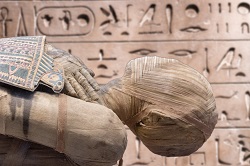Trending Science: Egyptians were mummifying their dead much earlier than previously thought
For many years, the scientific community believed Egypt’s prehistoric mummies were created by chance. There’s more and more evidence now that suggests people contributed to preserving them. New research in the ‘Journal of Archaeological Science’(opens in new window) shows that the ancient Egyptians were embalming the dead 1 500 years earlier. Archaeologists can thank one of the oldest intact mummies in the world for the discovery. Earliest known Egyptian embalming recipe The mummy, which dates from around 3 700-3 500 BC and is housed in the Egyptian Museum in Turin, Italy, had never undergone any conservation treatments. This gave the scientific team led by the Universities of York and Macquarie in the United Kingdom and Australia, respectively, a unique opportunity to accurately analyse the mummy. Forensic chemical tests revealed an embalming practice that suggests the Turin mummy was no accident. The team unveiled the original ancient Egyptian embalming recipe that was first used to preserve bodies and protect them from decay. This is the first-ever undeniable scientific evidence for the use of embalming on an intact, prehistoric Egyptian mummy. The results also provide the first evidence that the recipe was being used over a wider geographical area. The recipe contained antibacterial agents used in similar amounts to those employed by the Egyptian embalmers when their practice was at its peak some 2 500 years later. The mummy “literally embodies the embalming that was at the heart of Egyptian mummification for 4 000 years,” archaeologist from the University of York and study co-author Dr Stephen Buckley told the ‘BBC’(opens in new window). “Until now,” he explained, “we’ve not had a prehistoric mummy that has actually demonstrated – so perfectly through the chemistry – the origins of what would become the iconic mummification that we know all about.” Work on the mummy has led to even more discoveries. The ritual mummification procedure took place around 3 600 BC on a male. He was between 20 and 30 years old when he died. Egyptian mummification process comes to light Speaking to the UK’s ‘Daily Mail’(opens in new window), study co-author Dr Jana Jones, Egyptologist and expert on ancient Egyptian burial practices from Macquarie University, said the discovery was a “momentous contribution to our limited knowledge of the prehistoric period.” She added that it provided “vital, new information on this particular mummy.” Prof. Tom Higham, Deputy Director of the Oxford Radiocarbon Accelerator Unit in the United Kingdom, noted: “There are very few mummies of this ‘natural’ type available for analysis. … Our radiocarbon dating shows it dates to the early Naqada phase of Egyptian prehistory, substantially earlier than the classic Pharaonic period, and this early age offers us an unparalleled glimpse into funerary treatment before the rise of the state.” He stressed the importance of the study, which he was also a part of: “The results change significantly our understanding of the development of mummification and the use of embalming agents and demonstrate the power of interdisciplinary science in understanding the past.”
Countries
United Kingdom



